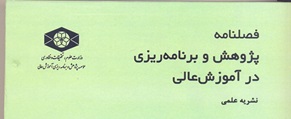ارتباط رهیافتهای یادگیری با ترجیحات آموزشی دانشجویان
نویسنده
گروه برنامه ریزی آموزش عالی، مؤسسه پژوهش و برنامهریزی آموزش عالی
چکیده
دانشجویان به طرق مختلف مطلب مورد یادگیری را پردازش و درک می کنند. رهیافت یک نظریه هدفدار است که نشان میدهد دانشجو چگونه مطالب درسی را یاد میگیرد. یادگیرنده با توجه به نیازهای محیط و اهداف شخصی رهیافت خود را انتخاب میکند. بعضی از دانشجویان مفاهیم جدید را با دقت بررسی و بر نکات اصلی تمرکز میکنند تا بتوانند معنی مطلب را بفهمند (رهیافت عمیق)، بعضی دیگر اطلاعات را به صورت غیرفعال دریافت میکنند، به بخشهای یادگیری به صورت جداگانه می نگرند و مطالب را حفظ میکنند (رهیافت سطحی) و برخی دیگر برای یادگیری برنامهریزی میکنند، از راهبردهایی استفاده میکنند که بتوانند اطلاعات را درک و تنظیم کنند و نسبت به نیازهای ارزیابی حساس هستند (رهیافت کسب موفقیت). هدف اصلی این پژوهش پیدا کردن رهیافتهای یادگیری دانشجویان است. هدف دوم پیدا کردن ارتباط رهیافتهای یادگیری دانشجویان و ترجیحات آموزشی آنان است. در این پژوهش 135 دانشجوی دانشکده پزشکی دانشگاه شهید بهشتی (85 دختر و 53 پسر) با میانگین سنی 57/19 در دروس میکروبیولوژی، ژنتیک و انگل شناسی شرکت کردند. روش تحلیل دادهها تحلیل عاملی، روش استخراج حداکثر درستنمایی و روش چرخش واریمکس با استفاده از برنامه SPSS بود. سه عامل رهیافت سطحی، رهیافت کسب موفقیت و رهیافت عمیق با ارزشهای ویژۀ « بیش از یک» استخراج شد. متغیرهای در برگیرنده هر عامل با یکدیگر سازگاری درونی داشتند (8/0> α). دو آزمون تحلیل عاملی و همبستگی پیرسون ارتباط آماری مثبت و معنی دار بین رهیافت عمیق و رهیافت کسب موفقیت با ترجیح برای درک مطلب و رهیافت سطحی با ترجیح برای ارائه مجدد اطلاعات را نشان داد. در این پژوهش عوامل محیطی نیز که یادگیری عمیق را تشویق میکند، مورد بحث قرار گرفته است.
کلیدواژهها
عنوان مقاله [English]
The Relationship between Approaches to Learning and Preferences for Instructional Methods
نویسنده [English]
- Mehrnaz Roshanaei
Department of Education Planning, Institute for Research and Planning in Higher Education
چکیده [English]
The study aims to determine medical students’ approaches to learning and to assess whether these are related to the educational preferences of individual learners. Students perceive and process information in a very different way. The use of a specific approach depends on the needs of the environment and the learner’s own objectives. Some students look for the overall meaning of the material and intend to understand the learning material (deep approach). Other students focus upon the details of the information and emphasis upon memorizing individual details (surface approach). Still other students plan, use strategies to monitor and control their learning and have alertness to assessment demands (achieving apporoach). A maximum likelihood factor analysis of 135 medical students (82 females, 53males) mean age 19.57 drown from Shahid Beheshti Medical School produced 3 factor solution (surface, achieving, and deep approach) with Eigen Values greater than one. The results indicate that the variables underlying each factor were internally consistenT 0.80. Two experiments factor analysis and correlation report that deep approach is associated with a preference for instruction which encourages and challenges understanding. On the other hand, the surface approach is linked with a preference for instruction, which transmits information. The discussion focuses on interventions that may encourage the use of deep approach to learning.
کلیدواژهها [English]
- College Students’ Learning
- Instructional Preferences
- Interacting Vigorously with the Content
- Learning Approaches
- Learning Environment
- Relating Concepts
- Seeking to Understand
- and Memorizing Information
 فصلنامه پژوهش و برنامه ریزی در آموزش عالی
فصلنامه پژوهش و برنامه ریزی در آموزش عالی
